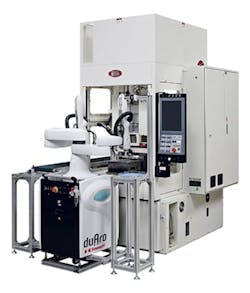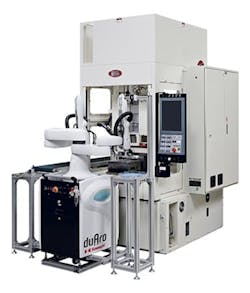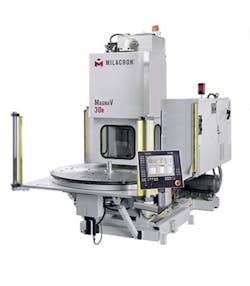Vertical injection machines boast features to help users
Although the word ergonomics is based on the ancient Greek words ergon (work or labor) and nomos (natural law), the importance of the discipline wasn't well understood until society was decades into the Industrial Revolution. When line workers began performing the same motions hundreds or thousands of times a day, however, businesses quickly saw the value in strategies that could make those movements faster and more precise.
Like their peers in other sectors of the industry, manufacturers of vertical injection molding machines (IMMs) always are looking for ways they can use technology to make operating a press faster, safer and more user-friendly for humans — even when the goal is to remove them from the process completely.
Nissei
Nissei has introduced several user-friendly upgrades to its STX line of compact, vertical hybrid IMMs, which consists of two base models: the 11-ton STX10 and the 22-ton STX20 (the latter will be on display at NPE in Orlando). They come with the company's newest controller, the Tact IV, which can be connected to a network for data sharing and features a number of enhancements specifically targeting operator productivity and ease of use.
"Some of the user-assisting help features of the Tact IV controller are things as simple as 'min-max settings' that appear on the screen whenever a parameter is going to be changed," said Steve Cunningham, Nissei's national sales manager. "This saves users time because they don't have to look them up, and it enhances safety by ensuring errors won't be made.
"Colors are used to represent pressure, velocity, temperature, actual settings and so on, while maintenance schedules come up daily, weekly, monthly and even annually. They're all designed to ensure it's a safe, well-running machine," he said.
In the future, however, Nissei increasingly will be looking beyond ergonomic features and upgrades because, quite frankly, robots don't need them — and in the future, robots will be the ones working with vertical IMMs a lot more than people, Cunningham said.
"Going forward, we're going to be looking not so much for ways to make things more comfortable and productive for humans working on these machines," he said. "We're going to be looking for new ways to increase the use of automation. Jobs like this, which largely consist of standing there and inserting and removing things at a press, are going to be handled by robots in the future. They're faster and more precise with repetitive motions, and they don't get bored doing the same thing over and over, all day long."
Nissei has taken several steps to facilitate the use of automation on machines in the STX line. First, the machines' doors and side panels are equipped with larger openings that make it easier for robots to access the internal table. The machine interface also has been improved, making it easier for robots to communicate with the machine. Finally, in what is becoming an industry trend, Nissei designs specific areas on its STX machines to make it easier to mount robots or anchor automation components.
"To ensure that automation, robots, and machines are perfectly aligned, it is necessary to bolt the machines together," Cunningham explained. "In many cases, there must be machined areas on the frame that the automation can bolt onto, ensuring that the alignment is always perfect."
The STX series builds upon the success of the company's existing ST line and features Nissei's hybrid X-Pump system, which saves energy and money by rotating the servo motor only when it's needed, and always at the lowest possible speed. The company said it also offers a high level of repeatability and control, making it ideally suited for the production of precise, high-quality parts.Regardless of what type of products they're making, Cunningham believes that increasing the use of automation on vertical IMMs is the best kind of ergonomic improvement that can be made."I think the ultimate ergonomic design is through automation," he said. "It can be something as simple as a SCARA robot picking and placing inserts, or as complicated as a coil of steel being cut and formed into electronic inserts on reel-to-reel applications. There is a place for automation in virtually every application, especially when it can help control costs.
"Let robots do the repetitive jobs that hurt people, and let people design, build and maintain the automated cells any time they can," he said.
Milacron
Milacron now is offering customers an upgrade to its popular Magna Vertical line of IMMs: an enhanced version of its established Mosaic controls platform.
The new Mosaic+ control offers a 21-inch color touch screen and is easier to learn and use because it went through an efficiency redesign that removed or combined unnecessary buttons. Milacron adds that the new version also is easier to program than its predecessor. It is swing-arm-mounted and offers IP65 protection against dirt and other contaminants.
The Mosaic+ allows users to see additional screens, such as mold temperature controls, while still viewing a primary control screen. It also makes it possible to implement a variety of new features, such as remote cameras.
Due to its enhanced performance, Mosaic+ will become the global standard for all Milacron machine controls, said Randy Roth, the company's product manager for the Magna Vertical line.The Magna Vertical line includes six models, with clamping forces ranging from 30 tons to 280 tons. They feature a tie-bar-less design that eliminates obstructions when running larger inserts, making movements more efficient regardless of whether it's a human or robot making them.
"The C-frame design of the Magna Vertical is robust and open in the front and on the sides," Roth said. "This design gives us the ability to use stationary, large rotary and shuttle tables for increased mold capacity utilizing less floor space. It provides easy access for mold changing, plumbing and access to molds for automation."
The C-frame easily accommodates many of the parts that are molded on vertical clamps, such as hose and cable ends, he added, and the machine's rotary table allows the user to load inserts while another part is being molded. More than one operator or robot can work on the machine simultaneously; workers can sit or stand while the machine is being used.
The Magna Vertical line has three table options: stationary for dedicated applications; a rotary table that offers greater flexibility for multiple applications as well as options for automation; and a shuttle table that can simultaneously load and unload parts, as well as accommodate inserts that are too long for a rotary table.
Like Nissei, Milacron sees the direct relationship between ergonomics and automation as they apply to vertical injection molding.
"Milacron supplies machines to customers who automate their cells to improve the ergonomics. It could be a robot placing an insert into the mold or picking the part, or labeling the part via decal, bar code, or stamping [ink]," Roth said.
As long as people are operating vertical IMMs, manufacturers will look for ways to make their work safer and more efficient. Roth believes that "one-touch" systems, which Milacron often implements for safety purposes, are one approach that can help.
"One-touch devices, in which users lay both hands on a sensor or light curtains, can help them avoid carpal tunnel [syndrome] and other ailments caused by the constant repetition of pushing a set of buttons," he said.
Michael T. McCue, copy editor
For more information
Milacron LLC,Batavia, Ohio, 513-536-2000, www.milacron.com
Nissei America Inc.,Anaheim, Calif., 714-693-3000, www.nisseiamerica.com


